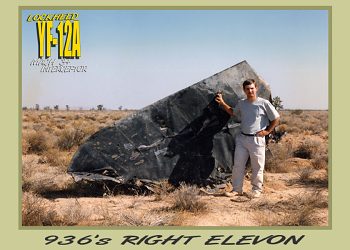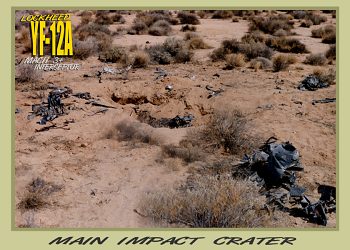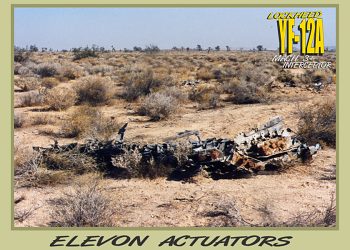UFO Crash Site
When Pete Merlin and Tony Moore, The X-Hunters, began researching the YF-12A crash, they found surprisingly little information. Press coverage at the time of the accident was sparse and the few articles available did not include photos of the crash site. The Air Force Flight Test Center History Office had no useful information, nor did NASA Dryden Flight Research Center. Pete ordered aerial photos of the crash site vicinity from the U.S. Geological Survey (USGS) and made a Freedom of Information Act (FOIA) request to the Air Force for the accident report.
One unlikely source of information was a book called A History of UFO Crashes by Kevin D. Randle. It listed an incident that occurred in the summer of 1971 "near Edwards Air Force Base." The narrative sounded like a garbled description of the YF-12A accident. A witness described hearing "a loud roaring sound and then a loud crash," and seeing a cloud of dust rising "several blocks away." She claimed to have walked to the crash site and joined a group of civilians who were "studying the craft" and "taking pictures." Air Force personnel then arrived, smashed the camera, and ordered the civilians to depart "or be arrested."
The witness said the vehicle "had no markings but seemed to be scratched. There were no windows or seams, and it appeared to be molded in one piece. It was a dark grayish color with greenish highlights. The texture was smooth." This could easily be a description of a damaged YF-12A engine nacelle. The witness said that military personnel "covered the craft with a large canvas and lifted it with cables" before hauling it away. The witness claimed that "there was no mention of the incident in the newspapers." This is consistent with the lack of media coverage noted by Pete and Tony. Kevin Randle classified the incident as neither genuine nor a hoax. He simply labeled it: "Insufficient Data."
The UFO crash story didn't add any really useful information to the search effort. The USGS photos finally arrived but were not immediately helpful. There was no obvious impact scar or evidence of excavation. Due to an administrative error, the accident report failed to arrive for two years and was not available as a reference during the search.
In the meantime the X-Hunters pooled what little information they had and began to search the desert on foot. Eventually, on 27 July 1996, Tony spotted a piece of titanium in the sand. A search yielded only a few other small pieces. They knew they were close, but had not yet found what they were seeking.
On 1 August, Pete returned to the spot where they had found the titanium fragments. Using an aerial photo to chart his progress, he followed a trail of debris for half a mile until he reached the main impact point.
The impact crater had apparently been filled in. The site was, in fact, visible in the aerial photo, but it was not very obvious. From the ground, however, the debris field was quite apparent.
Pete and Tony later documented the site. They found numerous pieces of titanium skin and structure with part numbers and inspection stamps. There were components from the inlet spike assemblies and the engines. The largest piece they found was the right outboard elevon.

© Copyright 2004-, The X-Hunters. All rights reserved. Copyright Policy Privacy Policy Page last modified 05/01/2023




